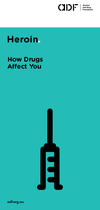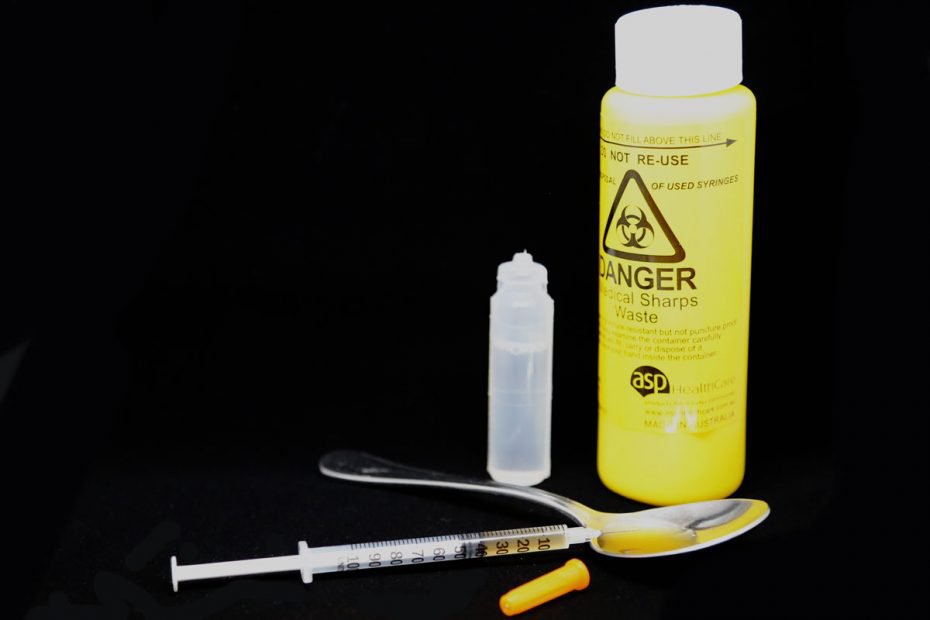
Heroin: How drugs affect you (bundle of 50)
Pamphlets
$36.32 (inc. GST)
View in ADF Shop
How is heroin used?
Heroin is usually injected into a vein, but it’s also smoked (‘chasing the dragon’), and added to cigarettes and cannabis. The effects are usually felt within seconds of injecting or smoking it, but will take around 10 to 15 minutes if snorted.2
Effects of heroin
Use of any drug can have risks. It’s important to be careful when taking any type of drug.
Heroin affects everyone differently, based on:
- the person’s size, weight and health
- whether the person is used to taking it
- whether other drugs are taken around the same time
- the amount taken
- the strength of the drug (it varies from batch to batch).
The main effects of heroin, which usually last for three to five hours, include:
- intense pleasure and pain relief
- relaxation and drowsiness
- confusion and clumsiness
- feelings of detachment
- slurred and slow speech
- slow breathing and heartbeat
- dry mouth
- tiny pupils
- reduced appetite and vomiting
- decreased sex drive.1-3
When injecting drugs, there is an increased risk of:
- tetanus
- infection
- vein damage.4
If sharing needles, there is an increased risk of:
- hepatitis B
- hepatitis C
- HIV and AIDS.4
Overdose
If you take a large amount or have a strong batch of heroin, you could overdose.
Heroin can cause death. Call an ambulance straight away by dialling triple zero (000) if you or someone else has any of the following symptoms (Emergency services are there to help and can provide instructions over the phone):
- extreme drowsiness or falling asleep (‘going on the nod’)
- small (‘pinned’) pupils
- low blood pressure
- irregular heartbeat
- cold, clammy skin
- slow breathing, blueish/grey lips and fingertips
- hypothermia
- passing out.1-3
Naloxone (also known as Narcan®) reverses the effects of heroin and other opioids, particularly in the case of an overdose. Naloxone can be injected intramuscularly (into a muscle) or delivered by intranasal spray.
For information about naloxone training and accessibility in your state or territory, get in touch with peak harm minimisation bodies or check the Pennington Institute website to find out what local service providers are delivering training.
Long-term effects
Regular use of heroin may eventually cause:
- intense sadness
- irregular periods and difficulty having children
- no sex drive, erectile dysfunction and infertility in men
- constipation
- dental issues
- damaged heart, lungs, liver and brain
- vein damage and skin, heart and lung infections from injecting
- needing to use more to get the same effect
- dependence on heroin
- financial, work or social problems.1-3
Heroin and mental health
Experiencing a dependence on heroin is likely to have a serious impact on mental health due to its effects on physical health, relationships, work/financial situation and general day-to-day functioning. Many people who use heroin regularly also have a history of mental health issues, including major depression, anxiety disorders, suicidal ideation, PTSD, personality disorders and experiences of trauma.5, 6
Tolerance and dependence
People who regularly use heroin can quickly become dependent on the drug. They may feel they need heroin to go about their normal activities like working, studying and socialising, or just to get through the day. They may also develop a tolerance to it, which means they need to take larger amounts of heroin to get the same effect.
Mixing heroin with other drugs
Mixing heroin with other drugs can have unpredictable effects and increase the risk of harm.
- Heroin & ice/speed/cocaine: heroin lowers your heart rate and methamphetamine speeds it up, masking the effects of each other. Depending on how much you take, you could overdose on either drug if one wears off before the other.
- Heroin & alcohol/GHB/benzos: high risk of overdose, may feel clumsy or uncoordinated, nausea and vomiting, slowed breathing, memory loss, passing out, and possible death.7
Use of more than one drug or type of drug consumed at the same time is called polydrug use.
More on Polydrug use
Polydrug use is a term for the use of more than one drug or type of drug at the same time or one after another. Polydrug use can involve both illicit drugs and legal substances, such as alcohol and medications.
Reducing harm
There are ways you can reduce the risk of harm when using heroin:
- Learn about carrying naloxone (reverses an opioid overdose) and encourage family and friends to do the same
- avoid mixing heroin with other depressant drugs such as alcohol or benzodiazepines – this can greatly increase the risk of overdose
- use around people you trust and somewhere you feel safe
- if using illicit opioids such as heroin, test with a small amount to reduce overdose risk
- do not drive or operate machinery after use
- if injecting, always use clean needles, never share injecting equipment and always wash your hands
- safely dispose of used injecting equipment.
Withdrawal
Giving up heroin after a long time is challenging because the body has to get used to functioning without it.
Withdrawal symptoms usually start within 6-24 hours after the last dose and usually last about a week - but can sometimes last up to ten days. Days one to three will be the worst. These symptoms usually can include:
- cravings for heroin
- restlessness and irritability
- anxiety
- depression and crying
- diarrhoea
- restless sleep and yawning
- stomach and leg cramps
- muscle spasms
- vomiting and no appetite
- goosebumps
- hot and cold flushes
- sweating
- runny nose and watery eyes
- insomnia, disturbed sleep
- fast heartbeat.1-3
Getting help
If your use of heroin is affecting your health, family, relationships, work, school, financial or other life situations, or you’re concerned about someone else, you can find help and support.
Call the National Alcohol and Other Drug Hotline on 1800 250 015 for free and confidential advice, information and counselling about alcohol and other drugs
Help and Support Services search
Find a service in your local area from our list. Simply add your location or postcode and filter by service type to quickly discover help near you.
If you're looking for other information or support options, send us an email at druginfo@adf.org.au
Path2Help
Not sure what you are looking for?
Try our intuitive Path2Help tool and be matched with support information and services tailored to you.

Federal and state laws provide penalties for possessing, using, making, selling, importing or exporting, or driving under the influence of heroin.
See also, drugs and the law.
National
- 1.2% of Australians aged 14 years and older have used heroin one or more times in their life.8
- Less than 0.1 % of Australians aged 14 years and older have used heroin in the previous 12 months.8
Young people
- Young Australians (aged 14–29) first try heroin at 18.5 years on average.8
- 1% of 12-17 year olds in Australia have ever used heroin.9
- Campbell A. The Australian Illicit Drug Guide: Every Person's Guide to Illicit Drugs--Their Use, Effects and History, Treatment Options and Legal Penalties: Black Inc; 2001 [07.02.2023].
- Brands B, Sproule B, Marshman J. Drugs and Drug Abuse. Toronto: Addiction Research Foundation; 1998 [22.02.2023].
- Black E, Shakeshaft A, Newton N, Teesson M, Farrell M, Rodriguez D. Heroin - What you need to know. National Drug and Alcohol Research Centre: UNSW Sydney; 2014 [14.09.2023].
- Tran LT, Peacock A, Colledge S, Memedovic S, Grebely J, Leung J, et al. Injecting risk behaviours amongst people who inject drugs: A global multi-stage systematic review and meta-analysis. International Journal of Drug Policy [Internet]. 2020 [12.09.2023]; 84:[102866 p.].
- Teesson M. Trajectories of heroin use: 10-11-year findings from the Australian Treatment Outcome Study. Addiction [Internet]. 2017 [14.09.2023]; 112(6):[1056 p.].
- Ross J, Teesson M, Darke S, Lynskey M, Hetherington K, Mills K, et al. Characteristics of heroin users entering three treatment modalities in New South Wales: Baseline findings from the Australian Treatment Outcome Study (ATOS). National Drug and Alcohol Research Centre Technical Report [Internet]. 2002 [13.09.2023]; (139).
- Hi-Ground. Heroin [24.05.2023].
- Australian Institute of Health and Welfare. National Drug Strategy Household Survey 2019 Canberra: AIHW; 2020 [11.04.2023].
- Guerin N, White V. ASSAD 2017 Statistics & Trends: Australian Secondary Students’ Use of Tobacco, Alcohol, Over-the-counter Drugs, and Illicit Substances Centre for Behavioural Research in Cancer: Cancer Council Victoria; 2018 [03.05.2023]. 92].

